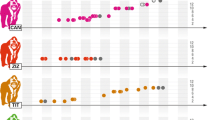Abstract
The wealthy elite males of nineteenth-century Krummhörn (Ostfriesland, Germany) achieved an above-average reproductive success. Membership in the elite class was determined from a list of the 300 richest men in the Ostfriesland district compiled by authorities in 1812. The main components establishing the link between cultural success and reproductive success are
-
1.
differences in the number of offspring owing to differences both in time spent in fecund marriage (mating success) and in rate of reproduction;
-
2.
differences in the probabilities of one’s adult offspring marrying locally vs. emigrating unmarried owing to differential ability to allocate resources that enhance the “social placement” of adult offspring; and
-
3.
differences in the probability of total reproductive failure (lineage extinction).
Contrary to what might be expected, infant survivorship was lowest amongst the richest families. We conclude that to a great extent females’ reproductive decisions contribute to the greater reproductive success of the elite males.
Similar content being viewed by others
References
Anderson, J. L., and C. B. Crawford 1993 Trivers-Willard Rules for Sex Allocation: When Do They Maximize Expected Grandchildren in Humans.Human Nature 4:137–174.
Betzig, L. L. 1986despotism and Differential Reproduction: A Darwinian View of History. New York: Aldine.
Boone, J. L. III 1986 Parental Investment and Elite Family Structure in Preindustrial States: A Case Study of Late Medieval-Early Modern Portuguese Genealogies.American Anthropologist 88:859–878.
Borgerhoff Mulder, M. 1987 On Cultural and Reproductive Success: Kipsigis Evidence.american Anthropologist 89:617–634.
1992 Reproductive Decisions. InEvolutionary Ecology and Human Behavior, E. A. Smith and B. Winterhalder, eds. Pp. 339–374. New York: Aldine de Gruyter.
Cronk, L. 1991 Human Behavioral Ecology.Annual Review of Anthropology 20:25–53.
Engel, C. 1990Reproduktionsstrategien im sozioökologischen Kontext. Doctoral dissertation, University of Göttingen.
Flinn, M. V. 1986 Correlates of Reproductive Success in a Caribbean Village.Human Ecology 14:225–243.
Henry, L., and A. Blum 1988Techniques d’analyse en démographie historique, second ed. Paris.
Hrdy, S. B., and D. S. Judge 1993 Darwin and the Puzzle of Primogeniture: An Essay on Biases in Parental Investment after Death.Human Nature 4:1–45.
Hughes, A. L. 1986 Reproductive Success and Occupational Class in Eighteenth-century Lancashire, England.social Biology 33:109–115.
Irons, W. 1979 Cultural and Biological Success. InEvolutionary Biology and Human Social Behavior: An Anthropological Perspective. N. A. Chagnon and W. Irons, eds. Pp. 257–272. North Scituate: Duxbury.
1993 Monogamny, Contraception and the Cultural and Reproductive Success Hypothesis.Behavioral and Brain Sciences 16:295–296.
Kaplan, H., and K. Hill 1986 Sexual Strategies and Social-class Differences in Fitness in Modern Industrial Societies.Behavioral and Brain Sciences 9:198–201.
Low, B. S. 1993 Ecological Demography: A Synthetic Focus in Evolutionary Anthropology.Evolutionary Anthropology 1:177–187.
Ohling, G. D. 1963 Kulturgeschichte des Krummhörn. InDie Acht und Ihre Sieben Siele, J. Ohling, ed. Pp. 17–288. Pewsum: Erster Entwässerungsverband Emden.
Pérusse, D. 1993 Cultural and Reproductive Success in Industrial Societies: Testing the Relationship at the Proximate and Ultimate Levels.Behavioral and Brain Sciences 16:267–322.
Røskaft, E., A. Wara, and Å. Viken 1992 Reproductive Success in Relation to Resource-access and Parental Age in a Small Norwegian Farming Parish during the Period 1700–1900.Ethology and Sociobiology 13:443–461.
Smuts, B. 1995 The Evolutionary Origins of Patriarchy.Human Nature 6:1–32.
Swart, F. 1910Zur friesischen Agrargeschichte. Leipzig: Duncker & Humblodt.
Vining, D. R. Jr. 1986 Social versus Reproductive Success: The Central Theoretical Problem of Human Sociobiology.Behavioral and Brain Sciences 9:167–216.
Voland, E. 1990 Differential Reproductive Success within the Krummhörn Population (Germany, 18th and 19th Centuries).Behavioural Ecology and Sociobiology 26:65–72.
Voland, E., and R. I. M. Dunbar 1995 Resource Competition and Reproduction: The Relationship between Economic and Parental Strategies in the Krummhörn Population (1720–1874).Human Nature 6:33–49.
Voland, E., and C. Engel 1990 Female Choice in Humans: A Conditional Mate Selection Strategy of the Krummhörn Women (Germany, 1720–1874).Ethology 84:144–154.
Voland, E., E. Siegelkow, and C. Engel 1991 Cost/benefit Oriented Parental Investment by High Status Families: The Krummhörn Case.Ethology and Sociobiology 12:105–118.
Weinrich, J. D. 1986 Intelligence, Reproductive Success, and Social Status: A Complicated Relationship.Behavioral and Brain Sciences 9:209–210.
Author information
Authors and Affiliations
Additional information
This study was made possible by financial support from the Deutsche Forschungsgemeinschaft and the Science Engineering and Research Council.
Heike Klindworth is a postgraduate student of biological anthropology; Eckart Voland currently teaches philoscophy at Giessen University. Both are interested in studying the evolution of human reproductive strategies by combining the sources and methods of historical demography with behavioral ecology theory.
Rights and permissions
About this article
Cite this article
Klindworth, H., Voland, E. How did the Krummhörn elite males achieve above-average reproductive success?. Human Nature 6, 221–240 (1995). https://doi.org/10.1007/BF02734140
Received:
Accepted:
Issue Date:
DOI: https://doi.org/10.1007/BF02734140




